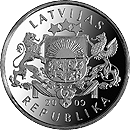Face value: 1 lats
Weight: 4.80 g, diameter: 21.75 mm
Metal: cupro-nickel
Struck in 2009 by Staatliche Münze Berlin (Germany)
Artists: Ilze Libiete (graphic design), Baiba Šime (plaster model)


Obverse
The large coat of arms of the Republic of Latvia, with the year 2009 inscribed below, is placed in the centre. The inscriptions LATVIJAS and REPUBLIKA, each arranged in a semicircle, are above and beneath the central motif respectively.
Reverse
Namejs ring encloses the numeral 1 with the inscription LATS in a semicircle below it.
Edge
Two inscriptions LATVIJAS BANKA (Bank of Latvia), separated by rhombic dots.
The Namejs ring is among the most often replicated Baltic jewellery pieces: jewellery craftsmen and wearers as well as archaeologists use this designation when referring to a certain type of ring. The ring is most popular with men, but women like to wear this kind of rings too. Historically, however, it was women who possessed and wore these rings. Such heavy rings with interlaced braiding were widespread in all territories inhabited by the Baltic tribes from the 12th century to early 15th century.
Craftsmen who made Namejs rings had to be (and are still to be) highly professional and skillful. As a rule, these rings were made of copper and only sometimes of silver. This type of ring was named after the Semigallian chieftain Namejs only in the 1930s when two such silver rings with interlaced braiding were found in the Daugmale castle mound and became favourites for replication and wearing. The popularity of the ring and, indeed, its very name originated with the novel "Namejs Ring" by Aleksandrs Grīns and a portrait of Namejs by Ludolfs Liberts, the latter being entirely a product of the artist's imagination.
In the national memory, with history and folk tales intertwining, a legend has emerged and the Namejs ring has become a symbol and the expression of Latvianess. When meeting a person wearing this ring anywhere in the world, even if he or she belongs to a different nation or has never stepped on the Latvian land, the Namjs ring has come to signify that by some intangible string, some invisible thread they are bound to Latvia.